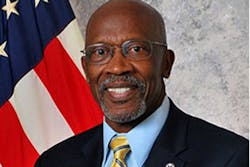Fire Administrator Advocates Technology at Workshop
U.S. Fire Administrator Ernest Mitchell Jr. says there’s been an evolution in technology in the fire service over the years and there’s no better time for it to continue and blossom than now.
“We can’t continue to use people to muscle things around and get things done,” said Mitchell who was a guest speaker at the seventh annual Precision Indoor Personnel Location and Tracking workshop in Worcester, Mass. “We have to think of ways to do it with technology.”
The workshop is sponsored by the U.S. Department of Homeland Security and Worcester Polytechnic Institute and is convened with the purpose of discussing the latest developments in firefighter location systems and the technology to support the effort.
In a room filled with stakeholders, representing academic researchers, commercial manufacturers, government officials and firefighters who are the end users of the technology, Mitchell said innovation is needed now more than ever as fire departments are stressed with budget and staffing cuts.
“We need your ideas, we need your knowledge and we need your technology,” Mitchell said to more than 120 people gathered for the event. “You should consider the fire service represented here to be a partner.” Mitchell’s presentation was called “Technology for Safety and Survival.”
Mitchell, who became the fire administrator in December, said it was his attendance at the workshop was “very meaningful and important” to him. He is the former fire chief of the Pasadena (Calif.) Fire Department and one of the original focus group members who got the workshop off the ground.
“The fire service has had a desperate need for a location system for years,” Mitchell said.
The fire service has been making progress to saving lives, having reduced the civilian fire death toll from 12,000 to about 3,500 annually in the past few decades, but that number is still high for an industrialized nation with a high standard of living. Additionally, while firefighter line of duty deaths has decreased, it also remains too high at about 100 annually, he said.
“We are in the business of saving lives and saving property,” Mitchell said, adding that virtually everyone else in the room was dedicated to the same purpose, just coming at it with a slightly different perspective.
In 1971, when Mitchell said he became part of the fire service, there were more and bigger fires and training on how to fight fire was not as a big deal as it is today. Fire calls today are 70 to 80 percent medical calls, on average, and responders today need more training on firefighting than they ever have previously. Technology can help overcome that problem, he said.
Technology can help commanders determine what is going on inside a building with firefighters conducting an interior attack, Mitchell said. Radios that work can keep communications open with not only those conducting fire operations, but those who have come into help from outside the community under mutual aid agreements.
“The issue is more about operability than interoperability,” Mitchell said. “Operability is key. Things have to work.” Interoperability is achieved through agreements and cooperation, not necessarily technology, he said, adding that “operability has tremendous needs.”
Firefighters work with clumsy gloves and in dark, smoky conditions, so anything firefighters need to operate should be designed with that in mind, he said.
“You have to be in the environment to truly understand it,” he said.
Mitchell said the fire service should take advantage of any technology made available, especially those that keep firefighters healthy and safe. Personal protective equipment (PPE) has continued to improve, but the SCBA facepiece continues to be the weakest link of the entire ensemble, Mitchell said.
“We need you to keep working on those kinds of problems,” Mitchell said.
With technology comes the risk of having too much information, he said, noting that situational awareness is always the most important aspect of what firefighters need most.
“We need to have knowledge and awareness of what we are truly facing, that’s what firefighters need to know,” he said. “We also need better ways to analyze the information that comes in.”
As the fire service shifts to more medical calls, the paramedics of the future will be increasingly linked to technology, Mitchell said. When he first was in the fire service, there wasn’t much more a responder could do for a trauma patient than to splint and bandage, he said.
Now, medics are in touch with doctors in hospitals with technology that can send EKGs and other information in real time. He predicted medics will continue to have wider and wider scopes of practices in the future, especially as the population ages and medical needs and calls increase.
He said he knows some medical programs have medics paired with nurses or physician assistants based in mobile home-like structures providing medical services.
“There will be a huge market for medical services in the future and great need for multifunction diagnostics.”
The fire side of the fire service is evolving as well as departments are called for miscellaneous services. He said the fire service is becoming sort of an “Uh Oh Squad” that responds to all emergency calls that are not criminal in nature.
Mitchell said the fire service needs the gifts of the innovators and researchers like those gathered inWorcesterand he encouraged them to support firefighting efforts with even more technology, but cautioned against “information overload” that responders can’t process quickly.
“We need you and we will use your technology,” Mitchell said. “It will become more and more useful for use in the future. …We need your gifts.”
